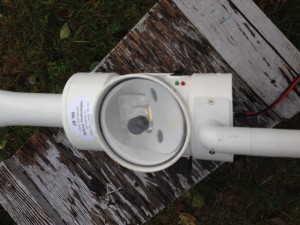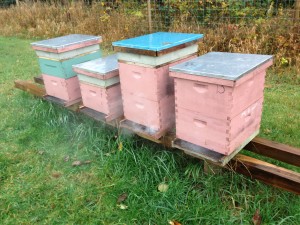This has been the week of new toys around the farm. The week started with arrival of the shiny new JB700 oxalic acid blower, which should make the job of hitting the mites with Oxalic Acid Vapors a LOT faster. Using the older pan style vaporizer, it takes roughly 4 minutes per colony to do a round of oxalic treatments. After placing the pan into the hive entrance and blocking it, the unit has to be powered for a minute and a half to get up to temperature, then left in place for another minute to finish vaporizing. Add another minute and a half to take it out, reload, and prepare the next colony, works out to 4 minutes per hive.
With the new JB700, things change a bit, no, a lot. A single load of Oxalic in this vaporizer will do 4 hives, and it’ll do them in under 2 minutes. You fill the pan in the vaporizer with the OA, turn it on, and about 30 seconds later the acid starts to sublimate. Turn on the fan and stick the nozzle into the entrance of the first hive. When you see the vapor coming out of the cracks at the top, move on to the next one.

Wow. I took this shot 2 minutes after I vaporized the hives with the new JB700. If I had any doubt about enough OA in the colonies from a blast out of this thing, I dont anymore.

On my first outing, I did all of our colones (currently 18 of them) in 20 minutes, but half of that time was spent testing the new toy and getting to understand how it works. I ran one load of OA thru from start to finish with it just sitting on top of a hive to get a feel for how much vapor comes out of this gadget. This video shows the result. Do watch to the end when I walk around and take show the cloud of OA vapour drifting across the bee yard.
JB700 in action
If that wasn’t enough new toys for the week, this weekend another one showed up on Sunday afternoon.

I think this will certainly change how we do a lot of things around here. The small flat deck will be more useful than a regular pick up box and is very convenient for hauling bee hives around.
Varroa has been an ongoing issue for us over the years, but, in most years we have managed successfully, more by accident than by design. 2015 was the exception, and late in the season that year we had a number of hives experience the classic ‘varroa crash’ during August. This inspired me to learn a lot more about this pest in hopes of better managing it in the future.
In years gone past, I always tended to think of varroa populations in terms of bee brood cycles, and in my mind I roughly considered varroa to double over the 3 week interval which is a worker brood cycle. Reading and learning about this pest showed me that was a very serious mistake in understanding this pest. After reading many papers, and lot of online information, I digested it all into my own ‘simple’ form which is essentially a distilled version of everything I have read about this pest. During the bee brood season, the varroa life cycle runs two distinctly different phases, as the math below will show. Using averages which come from lots of different sources, the short form of the active life cycle boils down to a few basic numbers. A fertile varroa mite has an average life expectancy of 27 days during the summer season when bees are brooding. Like the bees, they live much longer when the colony is broodless and they are in ‘winter survival’ mode, but we will ignore that phase for this discussion, and focus on varroa populations during our active work bee season.
The female varroa mite will enter a cell shortly before it is capped, and does her reproductive magic under the capping with the developing bee brood. For a worker cell, the capped phase is 11 days, and during that time the female will produce one male offspring, and averages say something like 1.5 females. We all know that 1.5 offspring is not possible, so it really means some of them manage 1, and some of them manage to produce 2. For the sake of keeping our math simple, and estimating conservatively, we will just consider the case of 1 offspring produced. So in the typical cell, when the bee emerges, we will have 2 viable mites emerge from a worker cell, then spend approximately 4.5 days as phoretic mites before they once again enter a cell to reproduce. These numbers tell us, the reproduction cycle of the varroa mite runs at 15 days. Now follow thru what happens on the next round. Both of these fertile mites will once again reproduce and create one new fertile female each, to emerge with the developing worker bee. At the end of this cycle, we have 4 mites emerging, but, the original foundress mite is now reaching the end of her lifespan, and dies. So the net result is this, with one fertile mite at the start of the cycle, we go thru two full reproductive mite cycles which takes 30 days in total, and we end up with 3 viable mites in the colony. With only worker brood present, we expect the mite population to triple every 30 days.
The math changes when we have drone brood present, the mites will prefer the drone brood to reproduce if it’s present. So now follow the same cycle, but this time for drone brood. After spending the 4 days in phoretic phase of life, the female enters a drone cell which will be capped for 14 days. Literature suggests that the average offspring in drone brood with 14 days under capping will be something like 2.5, but again, we know you cant produce half a mite, so we will just look at the round numbers, assume she is producing 2 viable offspring. They emerge when the drone emerges 14 days later, and proceed to spend 4 days in the phoretic phase before entering cells to reproduce. On the second cycle we now have 3 viable mites entering cells, and all of them will produce 2 offspring, for a total of 9 mites emerging at the end of the cycle. One of those mites is the original foundress who has now reached end of life and dies, if she hasn’t already died in the cell. 14 days under the capping and 4 days phoretic gives us an 18 day reproduction cycle, and with one mite at the beginning of the cycle, after two cycles (36 days) we have 8 viable mites in the colony. An increase by a factor of 8 over 36 days is equivalent to doubling over 12 days.
Armed with this understanding of the mite reproduction cycle, lets look carefully at one bee season in the Comox Valley, or more specifically on our little farm here south of Campbell River. Our records show that we see hazelnut pollen typically around Feb 10, and checking on our bees shows that they are indeed starting a round of brood at that time, and have been every year we have been here, so, Feb 10 is the start of our season. Now lets follow the math for one colony that enters the season with one, and only one, viable mite ready to enter a brood cell on Feb 10.
In the early season, we have only worker brood, so the mite population will triple over a 30 day period. One mite on Feb 10 will result in 3 viable mites 30 days later, March 12. Another two mite breeding cycles takes us to April 10, and we now have 9 mites in the colony, but things are changing. On April 10 we will have drone brood available for the mites to breed in, so, instead of tripling over 30 days, we now reach the time of the season where mites can double every 12 days on average. By April 22 our 9 mites becomes 18, then May 4 we are up to 36. May 16 the number is 72, and reaches 144 by May 28. By 9th of June that number is up to 288, then 576 by June 21, the mid summer solstice. Assume we do a count of our mites at this time via a sugar roll or wash, bee population will be up near 50,000 bees, and there are just over 500 mites in the colony, our wash numbers say 1%, and everybody is happy, we are well below the ‘economic threshold’ for mites. or are we ??????
Continue now thru mite breeding cycles and watch the numbers. With 576 in the colony on June 21, that becomes 1152 mites by the July 1 weekend, we are now at 2% infestation on July 3. By July 15, that number doubles again, and we now have 2304 mites in the colony, and the number climbs to above 4500 by July 27, and north of 9000 by August 8 for an 18% mite load. At this point, things will start to deteriorate rapidly for a number of reasons. First off, we have a mite on 1 out of 5 bees, but since mites prefer to stick with the nurse bees in the brood nest area, it’s more like one on every second bee in the brood nest, so we will be getting very unhealthy brood at this point, most of which will have mites in the cells, and to really compound this problem, it’s a time of year when the bees are contracting the brood nest and starting to think about raising winter bees.
All I can say to this after working thru the numbers is WOW, now I understand why the ‘typical mite crash’ happens thru the month of August, mites left unchecked at that point are growing in numbers exponentially over 12 day periods. But armed with knowledge, now we can start to think about how to better address this problem. One thing I learned from two decades in aviation, accidents dont just happen, they usually come about from a chain of small things that add up to one big thing, and the key to aviation safety is break that chain early in the process. This is why we developed systems of checklists, so we dont end up in the situation where one small item forgotten early in the process cascades to the big event farther down the chain. We can take the same attitude to our bees and mites, and just look at the chain of events of population doubling over various periods.
If I home in on the timeframes where drone brood is present in the hive, what really stands out is this. One mite we eliminate today, is 8 mites we wont have in 36 days, which becomes 64 we wont have in 72 days, ie 10 weeks down the road. Expand this by one more cycle of 36 days, and it’s 512 mites we will not have 108 days (15 weeks) down the road. So now if I do some calendar math, we see hives crashing from mites in the early August timeframe. Every mite we remove from a colony on May 1 is potentially 500 mites we will not see on August 15.
Doing the math on mite life cycles was an enlightening experience for me, it fully explained some of the things I’ve seen in the field, and more importantly, shows me the importance of mite control early in the season. If I do a sugar roll to count mites in May and find one, and only one mite on 300 bees, the typical thought train is that load is light enough to ignore. On average roughly 20% of the mites are going to be phoretic at any time, the rest are hiding under cappings with brood, so my population at that time is indeed 5 mites per 300 bees, about 1.5% which is a number we have always been told to be under the ‘economic threshold’ for mites. But left totally unchecked, that population is more than enough to grow exponentially thru the season and kill the colony by August. A sugar roll or wash count of 2 mites on May 1 left unchecked results in a dead hive in August.
The other really important detail I took from this exercise is looking at the phoretic phase, and the phase of mites in the cells under cappings. If we do an intervention that only gets phoretic mites today, after measuring a population of 1% with drones brood in the hive, then come back 12 days later and check again, the colony will look like we didn’t do anything, and measure roughly 2% infestation. An intervention that only gets phoretic mites will NOT show up in counts until _at least_ 18 days later, when the mite brood that would have been from those mites would start to emerge. In the meantime, all of those mites that were hiding under cappings will continue to emerge over that period. Reality is, if I do an intervention on July 1 of a type that only affects phoretic mites, by July 5 I would expect to see a 25% increase in the population when I check due to all the mites that emerged in the 5 days between intervention and testing. If I do a single intervention on July 1 that effectively eliminates phoretic mites, I dont expect to see a decline in numbers before July 20, and in the intervening 3 weeks, the numbers will continue to skyrocket upwards, so much so that by July 20 the effect will hardly be noticeable anyways. If all the mites were specific and jumping into cells exactly 4 days after emerging, we would see the noticeable difference around July 20, but, the 4.5 days phoretic is only and average, so by 20 days down the road the decrease will disappear in the averages.
There is lots of food for thought to ponder in all of this, but, this exercise of doing some simple math on the mite reproduction schedule has been enlightening for me, and has me seriously re-thinking mite strategies. My biggest takeaway from it all is, low counts early in the season are a leading indicator for hives crashing in August, not an indicator telling me ‘good enough’.
 Wow. I took this shot 2 minutes after I vaporized the hives with the new JB700. If I had any doubt about enough OA in the colonies from a blast out of this thing, I dont anymore.
Wow. I took this shot 2 minutes after I vaporized the hives with the new JB700. If I had any doubt about enough OA in the colonies from a blast out of this thing, I dont anymore.
 On my first outing, I did all of our colones (currently 18 of them) in 20 minutes, but half of that time was spent testing the new toy and getting to understand how it works. I ran one load of OA thru from start to finish with it just sitting on top of a hive to get a feel for how much vapor comes out of this gadget. This video shows the result. Do watch to the end when I walk around and take show the cloud of OA vapour drifting across the bee yard.
JB700 in action
If that wasn’t enough new toys for the week, this weekend another one showed up on Sunday afternoon.
On my first outing, I did all of our colones (currently 18 of them) in 20 minutes, but half of that time was spent testing the new toy and getting to understand how it works. I ran one load of OA thru from start to finish with it just sitting on top of a hive to get a feel for how much vapor comes out of this gadget. This video shows the result. Do watch to the end when I walk around and take show the cloud of OA vapour drifting across the bee yard.
JB700 in action
If that wasn’t enough new toys for the week, this weekend another one showed up on Sunday afternoon.
 I think this will certainly change how we do a lot of things around here. The small flat deck will be more useful than a regular pick up box and is very convenient for hauling bee hives around.
I think this will certainly change how we do a lot of things around here. The small flat deck will be more useful than a regular pick up box and is very convenient for hauling bee hives around.
